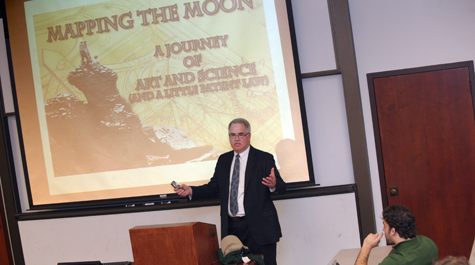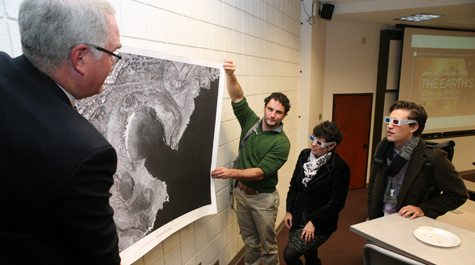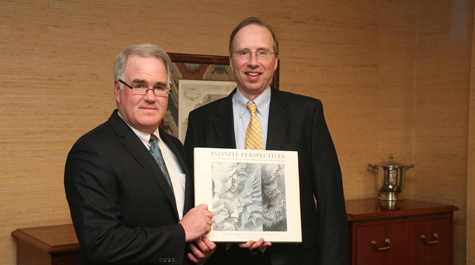Jeffrey Ambroziak on cartography, 3D moon maps and patent writing
The Student Intellectual Property Society at William & Mary Law School welcomed alumnus Jeffrey Ambroziak J.D. '98 on November 21 as he presented a talk detailing his journey to becoming the cartographer and inventor he is today. Beyond his success as a cartographer, Ambroziak also is a practicing patent strategy and patent prosecution attorney at GTC Law Group.
The seeds of Ambroziak's inventorship were sown at the Law School when, in the middle of his corporations class, Ambroziak came up with the idea of a 3D-perspective mapping tool. An avid fan of cartography, he realized that maps were static and could be viewed from only a single perspective. "What if you had an infinite number of projections?" he surmised. He later approached his patent law professor, George Helfrich, with the idea, asking if that type of technology was something that could be patented. Helfrich assured him that it was.
So, along with his father, Ambroziak developed the technology and, utilizing his combined engineering and legal knowledge, filed for a patent. He acknowledged that he faced a tough road with the U.S. Patent and Trademark Office, including six office actions interrogating the basis for the patent. He detailed the back-and-forth he had with the patent examiner, to the point that Ambroziak finally traveled to meet with the examiner in person. When Ambroziak asked the examiner why the application had not yet been approved, the examiner replied that he couldn't believe that no one had invented Ambroziak's technology before. The examiner eventually realized that his innovative idea was a first of its kind, and granted Ambroziak U.S. Patent No. 6,489,962 for his technology, now dubbed the Ambroziak Infinite Perspective Projection (AIPP). Ambroziak encouraged all the students in attendance to file a patent at some point in their careers, noting that "one of the interesting things about a patent law class is that you'll come out with the knowledge on how to write a patent."
Through his successes, Ambroziak has had the chance to interact with numerous individuals who shaped his life, including astronaut Sally Ride, author Ray Bradbury, and NASA flight director Gene Kranz. His maps have even had their own show in a prestigious New York art gallery, and can be found everywhere from elementary school classrooms to the private library of billionaire and space-aficionado Jay Walker.
Students attending the talk left inspired by his work. Monroe Tyler J.D. '16, the president of the Student Intellectual Property Society, stated, "Mr. Ambroziak is a great example of a William & Mary law student who brought an expertise to law school, applied his legal knowledge to it, and created something quite astounding." At the end of the talk, Ambroziak handed out copies of his famous 3D Moon Map--along with 3D glasses--and students could be seen marveling at the 3D projections on the map. He also showed off a currently in-development mobile app that harnesses the AIPP to display dynamic 3D maps of certain parts of the world.
Ambroziak donated a copy of the Moon Map signed by Gene Kranz to the Law School's Wolf Law Library, as well as a copy of his book, Infinite Perspectives: Two Thousand Years of Three-Dimensional Mapmaking (Princeton Architectural Press 1999).
About William & Mary Law School
Thomas Jefferson founded William & Mary Law School in 1779 to train leaders for the new nation. Now in its third century, America's oldest law school continues its historic mission of educating citizen lawyers who are prepared both to lead and to serve.
 Skip to main content
Skip to main content



